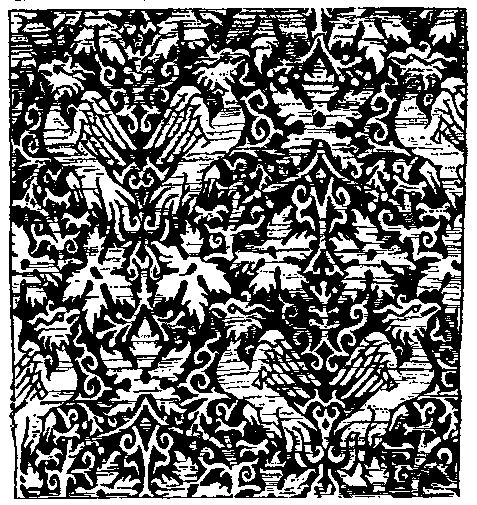, the name usually given to a class of richly decorative shuttle-woven fabrics, often made in coloured silks and with or without gold and silver threads. Ornamental features in brocade are emphasized and wrought as additions to the main fabric, sometimes stiffening it, though more frequently producing on its face the effect of low relief. These additions present a distinctive appearance on the back of the stuff where [v.04 p.0621]the weft or floating threads of the brocaded or broached parts hang in loose groups or are clipped away.
Fig. 2.—Part of a Siculo-Saracenic brocade woven in the 12th century. l6½ in. wide.
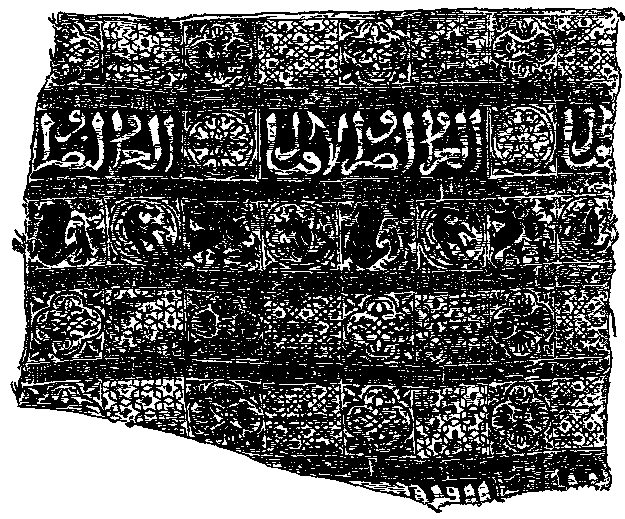
Fig. 1.—Brocade woven in red and olive green silks and gold thread on a cream-coloured ground. Along the top is the Kufic inscription "Arrahmān" (The Merciful) several times repeated in olive green on a gold-thread ground. Pairs of seated animals, addorsed regardant and geese vis-à-vis are worked within the lozenge-shaped compartments of the trellis framework which regulates the pattern. Both animals and birds are separated by conventional trees, and the latter are enclosed in inscriptions of Kufic characters. Siculo-Saracenic; 11th or 12th century. 5½ in. sq.
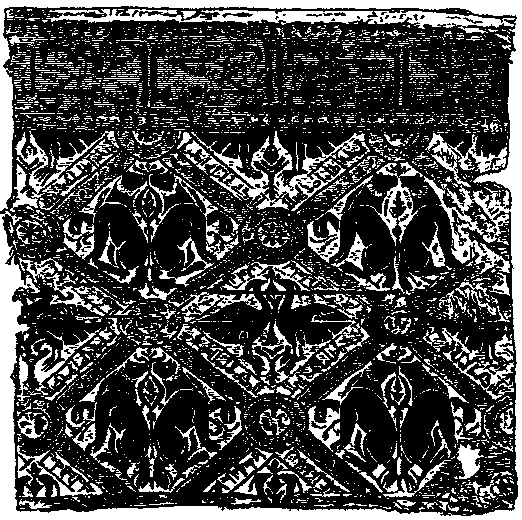
Fig. 3.—Piece of stuff woven or brocaded with red silk and gold thread, with an ogival framing enclosing alternately, pairs of parrots, addorsed regardant, and a well-known Persian (or Sassanian) leaf-shaped fruit device. Probably of Rhenish-Byzantine manufacture in the 12th or 13th century. 9 in. long.
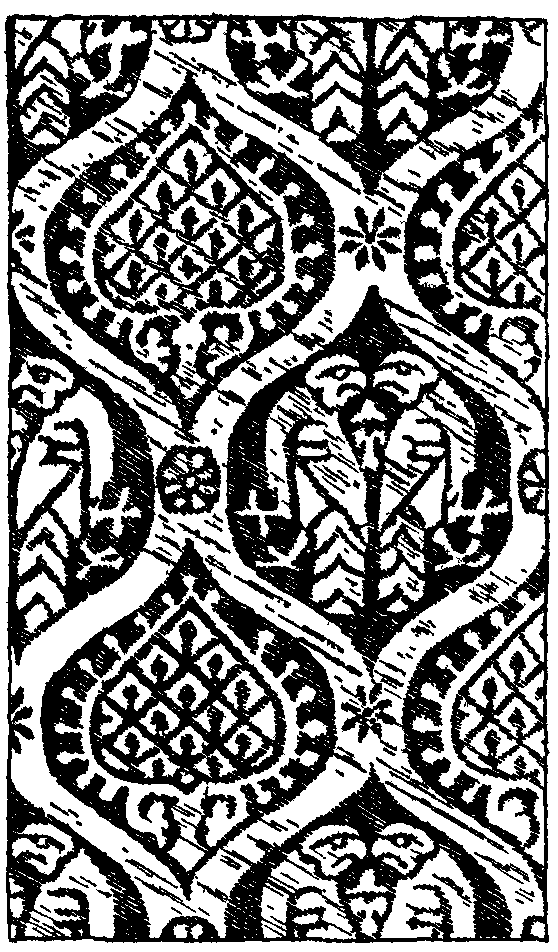
The Latin word broccus is related equally to the Italian brocato, the Spanish brocar and the French brocarts and brocher, and implies a form of stitching or broaching, so that textile fabrics woven with an appearance of stitching or broaching have consequently come to be termed "brocades." A Spanish document dated 1375 distinguishes between los draps d'or é d'argent o de seda and brocats d'or é d'argent, a difference which is readily perceived, upon comparing for instance cloths of gold, Indian kincobs, with Lyons silks that are brochés with threads of gold, silk or other material. Notwithstanding this, many Indian kincobs and dainty gold and coloured silk-weavings of Persian workmanship, both without floating threads, are often called brocades, although in neither is the ornamentation really broché or brocaded. Contemporary in use with the Spanish brocats is the word brocado. In addition to brocarts the French now use the word brocher in connexion with certain silk stuffs which however are not brocades in the same sense as the brocarts. A wardrobe account of King Edward IV. (1480) has an entry of "satyn broched with gold"—a description that fairly applies to such an enriched satin as that for instance shown in fig. 4. But some three centuries earlier than the date of that specimen, decorative stuffs were partly brochés with gold threads by oriental weavers, especially those of Persia, Syria and parts of southern Europe and northern Africa under the domination of the Saracens, to whom the earlier germs, so to speak, of brocading may be traced. Of such is the 11th or 12th century Siculo-Saracenic specimen in fig. 1, in which the heads only of the pairs of animals and birds are broched with gold thread. Another sort of brocaded material is indicated in fig. 2, taken from a part of a sumptuous Siculo-Saracenic weaving produced in coloured silks and gold threads at the famous Hotel des Tiraz in Palermo for an official robe of Henry IV. (1165-1197) as emperor of the Holy Roman Empire, and still preserved in the cathedral of Regensburg. Fig. 3 is a further variety of textile that would be classed as brocat. This is of the 12th or 13th century manufacture, possibly by German or Rhenish-Byzantine weavers, or even by Spanish weavers, many of whom at Almeria, Malaga, Grenada and Seville rivalled those at Palermo. In the 14th century the making of satins heavily brocaded with gold threads was associated conspicuously with such Italian towns as Lucca, Genoa, Venice and Florence. Fig. 4 is from a piece of 14th-century dark-blue satin broached in relief with gold thread in a design the like of which appears in the background of Orcagna's "Coronation of the Virgin," now in the National Gallery, London. During the 17th century Genoa, Florence and Lyons vied with each other in making brocades in which the enrichments were as frequently of coloured silks as of gold intermixed with silken threads. Fig. 5 is from a piece of crimson silk damask flatly brocaded with flowers, scroll forms, fruit and birds in gold. This is probably of Florentine workmanship. Rather more closely allied to modern brocades is the Lyons specimen given in fig. 6, in which the brocading is done not only with silver but also with coloured silks. Early in the 18th century Spitalfields was busy as a competitor with Lyons in manufacturing many sorts of brocades, specified in a collection of designs preserved in the national art library of the Victoria and [v.04 p.0622]Albert Museum, under such trade titles as "brocade lutstring, brocade tabby, brocade tissue, brocade damask, brocade satin, Venetian brocade, and India figured brocade." Brocading in China seems to be of considerable antiquity, and Dr Bushell in his valuable handbook on Chinese art cites a notice of five rolls of brocade with dragons woven upon a crimson ground, presented by the emperor Ming Ti of the Wei dynasty, in the year A.D. 238, to the reigning empress of Japan; and varieties of brocade patterns are recorded as being in use during the Sung dynasty (960-1279). The first edition of an illustrated work upon tillage and weaving was published in China in 1210, and contains an engraving of a loom constructed to weave flowered-silk brocades such as are woven at the present time at Suchow and Hangchow and elsewhere. On the other hand, although they are described usually as brocades, certain specimens of imperial Chinese robes sumptuous in ornament, sheen of coloured silks and the glisten of golden threads, are woven in the tapestry-weaving manner and without any floating threads. It seems reasonable to infer that Persians and Syrians derived the art of weaving brocades from the Chinese, and as has been indicated, passed it on to Saracens as well as Europeans.
(A. S. C.)
Fig. 6.—Piece of pink silk brocaded in silver and white and coloured silks. French middle 18th century; about 15 in. square.
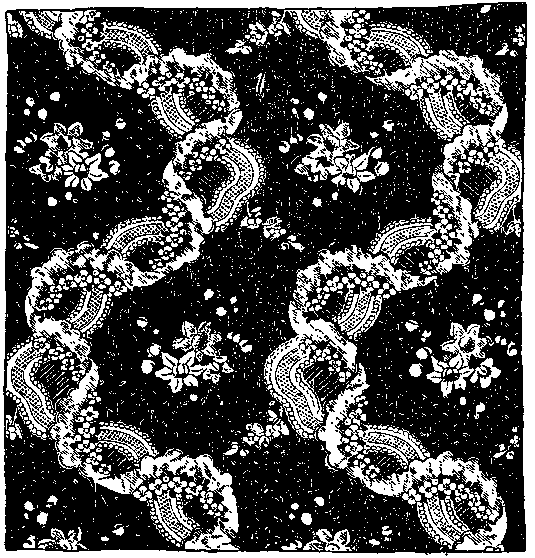
Fig. 5.—Piece of crimson silk damask brocaded in gold thread with symmetrically arranged flowers, scrolls, birds, &c. Italian (?Florentine). Late 17th century; about 2 ft. 6 in. long.
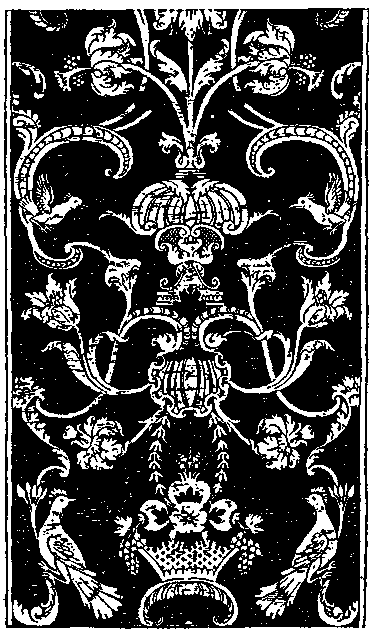
Fig. 4.—Piece of blue satin brocaded with gold threads. The unit of the pattern is a symmetrical arrangement of fantastic birds, vine leaves and curving stems. The bird shapes are remotely related to, if not derived from, the Chinese mystical "fonghoang." North Italian weaving of the 14th century; about 11 in. square.
